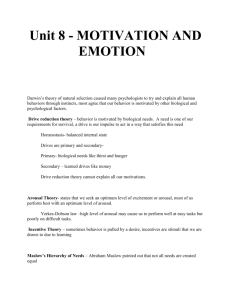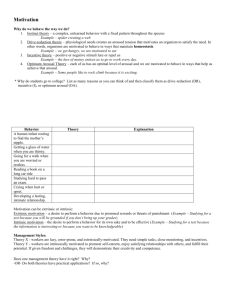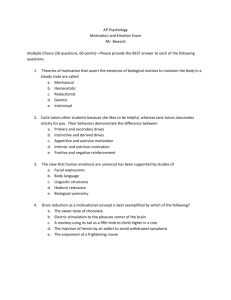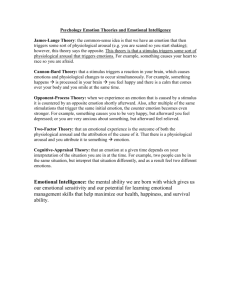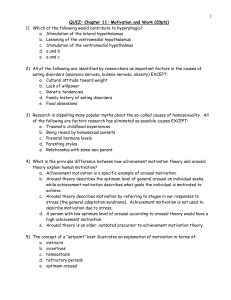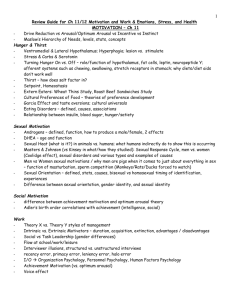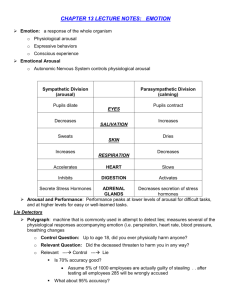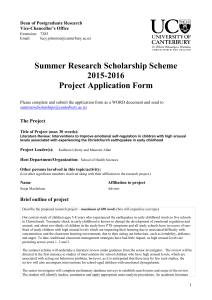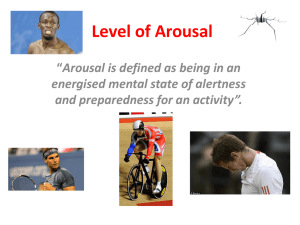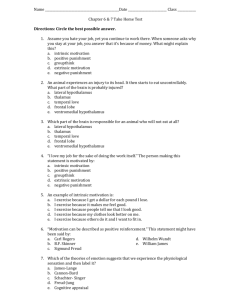motivation and emotion - Point Loma High School
advertisement
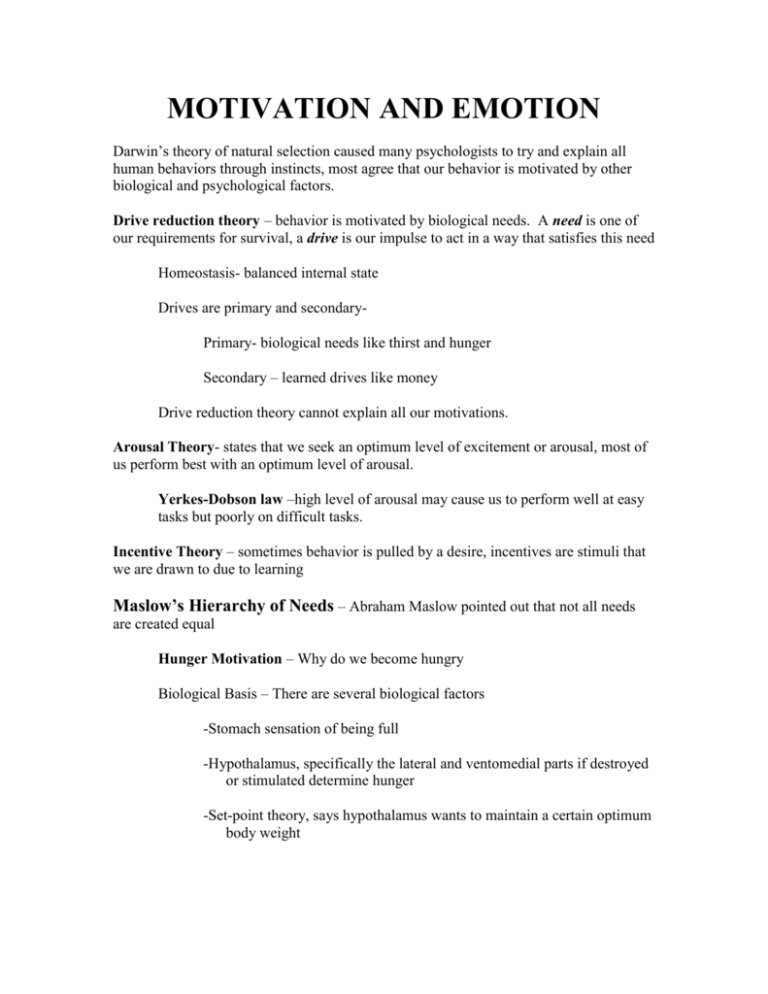
MOTIVATION AND EMOTION Darwin’s theory of natural selection caused many psychologists to try and explain all human behaviors through instincts, most agree that our behavior is motivated by other biological and psychological factors. Drive reduction theory – behavior is motivated by biological needs. A need is one of our requirements for survival, a drive is our impulse to act in a way that satisfies this need Homeostasis- balanced internal state Drives are primary and secondaryPrimary- biological needs like thirst and hunger Secondary – learned drives like money Drive reduction theory cannot explain all our motivations. Arousal Theory- states that we seek an optimum level of excitement or arousal, most of us perform best with an optimum level of arousal. Yerkes-Dobson law –high level of arousal may cause us to perform well at easy tasks but poorly on difficult tasks. Incentive Theory – sometimes behavior is pulled by a desire, incentives are stimuli that we are drawn to due to learning Maslow’s Hierarchy of Needs – Abraham Maslow pointed out that not all needs are created equal Hunger Motivation – Why do we become hungry Biological Basis – There are several biological factors -Stomach sensation of being full -Hypothalamus, specifically the lateral and ventomedial parts if destroyed or stimulated determine hunger -Set-point theory, says hypothalamus wants to maintain a certain optimum body weight Psychological factors -external cues, attractiveness or availability of food -Garcia effect, learned taste aversions -Culture and background Eating Disorders – different cultures have drastically different rates of eating disorders, rates are highest in the U.S. The three most common are: Bulimia – Bulimics eat large amounts of food in a short period of time and then get rid of the food by vomiting, excessive exercise, or the use of laxatives. (Binge then Purge) Bulimics are obsessed with food and their weight, the majority of bulimics are women Anorexia Nervosa - Anorexics starve themselves to below 85 percent of their normal body weight and refuse to eat due to their obsession with weight, the vast majority are women Obesity – People with diagnosed obesity are severely overweight, often over 100 pounds, and the excess weight threatens their health. Obese people typically have unhealthy eating habits rather than the food obsessions of the other two disorders. Some people may also be genetically predisposed to obesity Social Motivation – Achievement Motivation – Humans seem to be motivated to figure out our world and master skills, sometimes regardless of the benefits of the skills or knowledge. Studies involve looking at differences in how people set and meet personal goals and go about acquiring new knowledge or skills. Extrinsic/Intrinsic MotivationExtrinsic motivators are rewards that we get for accomplishments from outside ourselves Ex. Grades, salary, etc. Intrinsic motivators are rewards we get internally, such as enjoyment or satisfaction Knowing what type of motivation an individual responds best to can give managers insight into what strategies will be most effective. Extrinsic motivators are effective for a short period of time but studies show that if we want a behavior to continue, intrinsic motivation is most effective. Management Theory – studies of management styles show two basic attitudes that affect how managers do their jobs: Theory X – managers believe that employees will work only if rewarded with benefits or threatened with punishment Theory Y – managers believe that employees are internally motivated to do good work and policies should encourage this internal motive. Theory J -- THEORIES ABOUT EMOTION – James-Lange – They theorized that we feel emotion because of biological changes, physiological change causes emotion Cannon-Bard – They doubted this order, they demonstrated that similar physiological changes correspond with drastically different emotional states. Biological change and the cognitive awareness of the emotional state occur simultaneously Two Factor Theory – Stanley Schacter explains emotional experiences in a more complete way than either previous. He pointed out that both our physical responses and our cognitive labels combine to cause any particular emotional response. Emotion depends on the interaction between two factors, biology and cognition. STRESS – stress and emotion are intimately connected concepts. The term stress can refer to either certain life events (stressors) or how we react to these changes in the environment (stress reactions) Measuring stress – Thomas Holmes and Richard Rahe designed one of the first instruments to measure stress. Their social readjustment rating scale (SRRS) measured stress using life-change units (LCUs). Any major life change increases the score on the SRRS, a person who scored very high on the SRRS is more likely to have stress-related diseases than a person with a low score. General Adaptation Syndrome (GAS) – Hans Seyle describes the general response in humans and animals to stressful events. There are three stages: Alarm reaction – Heart rate increases, blood is diverted away from other body functions to muscles needed to react. The organism readies itself to meet the challenge through activation of the sympathetic nervous system. Resistance – The body remains physiologically ready. Hormones are released to maintain this state of readiness. If the resistance stage lasts too long, te body can deplete its resources. Exhaustion – The parasympathetic nervous system returns our physiological state to normal. We can be more vulnerable to disease in this stage especially if our resources were depleted by an extended resistance stage. Various studies show that a perceived lack of control over events exacerbates the harmful effects of stress, control over events tends to lessen stress. MOTIVATION AND EMOTION QUIZ 1. How would drive reduction theory explain a person accepting a new hob with a higher salary but that requires more work and responsibility? A. Money is a more powerful incentive for this individual than free time. B. This person seeks a higher activity level and takes the job in order to satisfy this drive. C. For this person, money is a higher level need than free time. D. The person takes the job to satisfy the secondary drive of increased salary. E. Humans instinctively seek greater resources and control over their environment. 2. Which aspects of hunger are controlled by the lateral and ventromedial hypothalamus? A. contraction and expansion of the stomach, indicating too much or too little food. B. Body temperature and desire to eat. C. Desire to eat and physiological processes needed for eating, and digestion (such as salivation). D. The binge and purge cycle in bulimics. E. The desire to eat and the feeling of satiety or fullness, that makes us stop eating. 3. All of the following are identified by researchers as important factors in the causes of eating disorders EXCEPT A. B. C. D. E. cultural attitude toward weight lack of willpower. Genetic tendencies. Family history of eating disorders. Food obsessions 4. Research is dispelling many popular myths about the so-called causes of homosexuality, all of the following are factors research has eliminated as possible causes EXCEPT A. traumatic childhood experiences. B. Being raised by homosexual parents C. Relationship with same-sex parent D. E. Parenting styles. Prenatal hormone levels 5. What is the principle difference between how achievement motivation theory and arousal theory explain human motivation? A. Achievement motivation is a specific example of arousal motivation B. Arousal theory describes the optimum level of general arousal an individual seeks, while achievement motivation describes what goals the individual is motivated to achieve. C. Arousal theory describes motivation by referring to stages in our responses to stress (the general adaptation syndrome). Achievement motivation is not used to describe motivation due to stress D. A person with a low optimum level of arousal according to arousal theory would have a high achievement motivation. E. Arousal theory is an older, outdated precursor to achievement motivation theory. 6. Which of the following are reasons why intrinsic motivation might be more advantageous than extrinsic motivation? A. Intrinsic motivation might be more enduring since extrinsic motivations are usually temporary. B. Intrinsic motivations are easier and more convenient to provide. C. Intrinsic motivations are higher on Maslow’s hierarchy of needs, so we are motivated to meet them before extrinsic needs. D. Intrinsic motivations are more likely to be primary drives. Extrinsic motivations are secondary drives. E. Intrinsic motivations are more effective with a wider range of individuals. 7. Which sentence most closely describes the difference between theory X and theory Y types of management? A. Theory X managers are more active in work groups. Theory Y managers are more hands-off, letting groups work out problems on their own. B. The management theories differ in regard to what tasks they delegate to workers. C. Theory Y managers regard employees as intrinsically motivated,. D. Management theory X is dominant in collectivist cultures. Theory Y is more prevalent in individualist cultures. E. Theory Y is used with workers who have high optimum levels of arousal. Theory X is used with those whose arousal levels are low. 8. What does Schacter’s two-factor theory state about the relationship between emotion and physiological reaction? A. Emotions are caused by physiological reactions. For example, we feel excited because our heart begins to race. B. Physiological reactions are caused by emotions. For example, our experience of fear causes our breathing rate to increase. C. A combination of physiological reactions and our cognitive interpretation of an event produces emotion. D. Physiological reactions and emotional response occur simultaneously. E. Cognitive emotions occur independently of physiological states and are unrelated. 9. Excessive time spent in the resistance phase of Seyle’s general adaptation syndrome can contribute to A. B. C. D. E. increased time needed to adapt to new emotional situations. Decreased motivation to perform novel tasks Stress-related diseases like ulcers or heart conditions A reduction in the drive to achieve goals Resistance to learning skills needed for novel tasks. 10. Perceived control over a stressful event results in A. B. C. D. E. less reported stress. More frustration regarding the stressful event More motivation to solve the stressful problem Increased arousal Higher heart and respiration rates 11. The balanced physiological state we are driven to attain by satisfying our needs is called A. B. C. D. E. equilibrium homeostasis self-actualization primary satisfaction secondary satisfaction 12. The Garcia effect describes A. the increased motivation felt by individuals with high levels of arousal. B. The increased susceptibility to illness experienced in the exhaustion phase of the stress response C. Classical conditioning associating nausea with food or drink D. The effect of a theory Y management style. E. The effect the hypothalamus has on perceiving hunger 13. Which of the following factor does research indicate may influence sexual orientation? A. parenting styles B. degree of masculinity or femininity expressed in childhood C. traumatic childhood experiences D. genetic influences E. being raised by homosexual parents 14. Seyle’s general adaptation syndrome describes A. B. C. D. E. how the central nervous system processes emotions. The effect of low levels of arousal on emotion. Our reactions to stress. Our reactions to the different levels of Maslow’s hierarchy of needs. The sexual response cycle in humans 15. A high score on Holmes and Rahe’s social readjustment rating scale correlates with A. B. C. D. E. high optimum levels of arousal level of need reduction incidence of eating disorders incidence of stress-related illness levels of perceived control.
